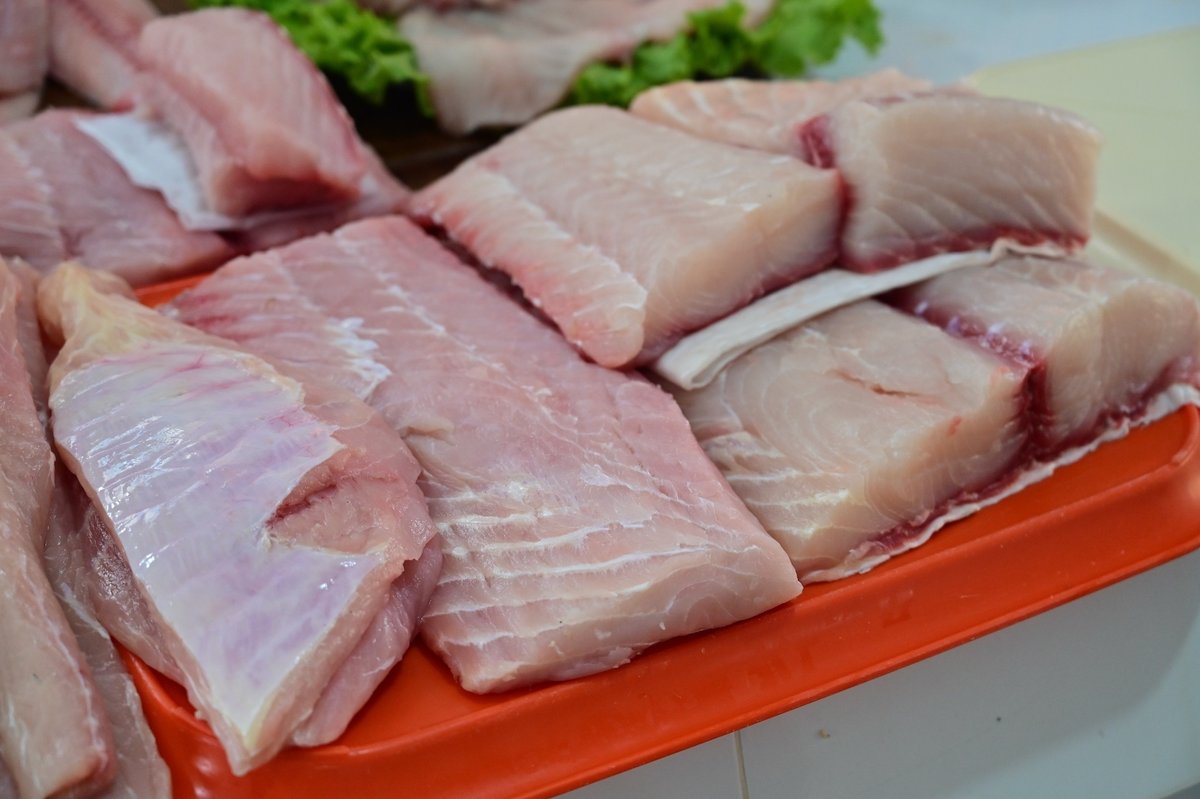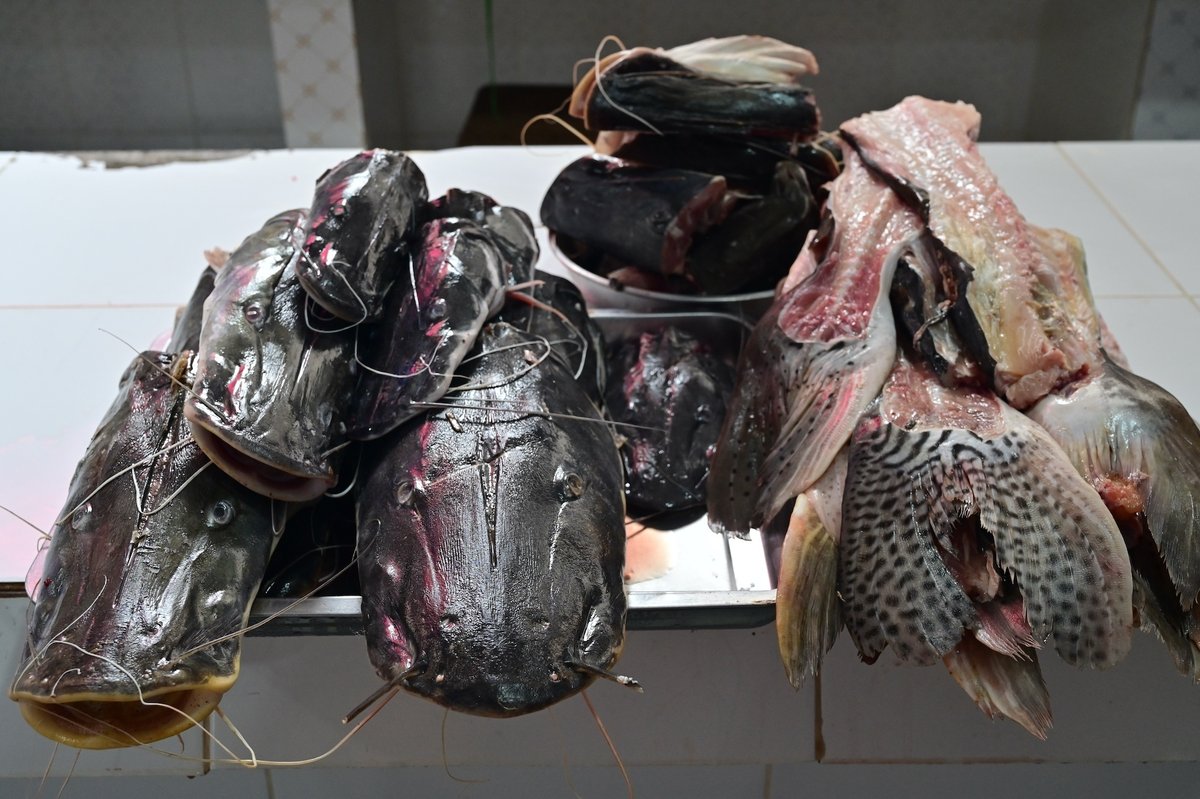
ペルー編6:アマゾンの台所ベレン市場
English follows Japanese
ベレン市場へ
2023年2月16日、早朝にアマゾン川でピンクのイルカと遊んだ後は宿に戻って簡単な朝食をいただいた。さて今日は何をしようか? と言っても、アマゾン川に浮かぶ宿では川で泳ぐくらいしかすることがない。
「イキトスのベレン市場に行きませんか?」とシャンカール・ノグチさん。
おお、それは良いアイディア! スパイスやインド料理の専門家のシャンカールさんと水野仁輔さんはアマゾンの唐辛子を調査しに来たわけだし、僕は世界中どこに行っても市場が大好きだ。
その場で調べると、ベレン市場は「アマゾンの台所」と呼ばれる巨大市場で、地域の農産物や肉、魚だけでなく、スパイスや花、民間薬や加工食品、更に日用品まで商う屋外市場。公式には231種類の野菜、60種の野生動物と56種の魚介(夜間には公式には扱えない動物も?)を扱っているそう。ただ治安の悪い地域にあるので、外国人観光客はスリなどに十分注意すること、とのこと。
セサールに相談すると、宿のモーターボートでナナイ橋の艀まで送ってくれることとなった。そこから先はトゥクトゥク(オートリキシャー)で往復出来るとのこと。早速モーターボートに乗り込み、ナナイ橋の艀まで行き、トゥクトゥクを拾ってベレン市場へと向かった。

開通したばかりでまだまだ交通量の少ないナナイ橋を渡り、イキトス市街に入り、更に20分ほど繁華街を南に下ると、ベレン市場のあるベレン地区に到着した。水野&シャンカール組のトゥクトゥクとは途中ではぐれてしまったが、市場のどこかで会えるだろう。
トゥクトゥクを降りると、初めて気温が30℃近いことに気づいた。宿はアマゾン川に浮いているので適度に涼しく、明け方は毛布が必要なくらいだが、真昼のイキトスの町は湿度も高くかなり暑い。路肩には数え切れないほどのオートバイが駐車しているのと相まって、まるで東南アジアの田舎町にいるような気分になった。
繁華街を川の方角に曲がり、道の真ん中まで屋台が陣取っている歩行者通りを進むと、目の前に青い色に塗られた建物ベレン市場が見えてきた。

冷蔵庫もエアコンもないウェットマーケット!
市場に続く道は週末のアメ横通りのように多くの人がひっきりなしに行き来していた。外国人観光客の姿はまれで、当然、東洋人は僕たちだけだ。
市場に一歩足をいれると、建物は東南アジアのウェットマーケットと同じように、背の高い吹き抜けになっていて、四方向の出入口には扉はなく、中には冷蔵庫もなければ冷房もない。東南アジアの市場では肉や魚はさすがに氷の上で冷やされて売られているが、ベレン市場はそれすらない。なので室内に入ると肉や魚の生臭い匂いが鼻につく。

入口付近で最初に目についたのはベーコンに似たオレンジ色の乾燥肉。屋台の台の上に巨大な緑の植物の葉っぱを敷き、その上に毒々しい色の肉塊が大小様々に並んでいる。これぞペルーについてから毎食のように口にしているセシーナ、アマゾン・ベーコンだ。豚肉だと思って食べていたが、実はカビパラの肉だったことが判明した。豚よりも脂が少なくあっさりした味がする。その他、肉の屋台では巨大な豚の正肉や捌いたばかりの丸鶏、更に様々な種類の豚の腸詰めが目立っていた。

ピラルクの身は鯛のように美しいピンク色
奥に進むと鮮魚コーナーだ。最も広い売り場面積を取っているのは鯛のように美しい薄いピンク色をした大きな白身魚のフィレ。皮を剥がし、長さ40~50cm、幅20cm、厚さ8cmほどの長方形にトリミングされているので元の姿が想像出来ないが、これが前日に養殖場で見かけた巨大魚ピラルクだった。

その隣にはまるで2トーン・スカのミュージシャンたちのような派手な黒白市松模様をした皮の魚。こちらはドンセラ=タイガーショベルノーズフィッシュと呼ばれる大型ナマズだ。3枚におろした状態で、あえて皮を剥がずに売られているのはピラルクと区別するためだろうか?

魚のフィレ売り場の隣には魚のアラ売り場も。長いヒゲが生えたドンセラの巨大な頭や背骨やアラがドーンとお皿に盛られている。スープなどに使うのだろうか?

次に目についたのは干したピラルクの身を海苔巻き状にクルクルと巻いたもの。ポルトガル料理に使う干したのバカリャウや韓国の干し鱈のプゴクを思い出す。一旦、干してしまえば長期保存も可能だろう。他にも大中小様々な魚の干物が並んでいた。

気温30℃の屋外で捌かれる甲冑魚
魚屋の隣には、様々な種類の海老や蟹、ムール貝、烏賊や蛸、ひじきに似た海藻などの専門店があった。海老や蟹は淡水産のものだけでなく、海水産のものも混じっている。太平洋岸から飛行機で運ばれてくるのだろうか? また、海老やイカ、蛸は一口大に刻んで混ぜ合わせ、レモン汁に漬けたセビーチェ用シーフードミックスとしても量り売りされていた。

建物の裏口から出ると、狭い道に沿って木枠にビニールシートを貼っただけの屋台がずらっと並んでいた。
川魚の屋台では先住民のお姉さんが真っ黒でグロテスクな見た目の甲冑魚カラチャマを捌いていた。カラチャマは日本ではプレコという名前で熱帯魚好きの間で知られる珍しい甲冑魚。良い出汁が出るので、そのまま姿煮にしてスープを楽しむのだそう。お姉さんは慣れた手つきで腹に指を入れ、浮袋を引っ張り出し、僕たちに見せてくれた。真紅の浮袋は魚の新鮮さを物語っているが、外気温は30℃だよ……。

小分けにして売られる唐辛子ソース
野菜の屋台では赤や黄色や緑の唐辛子が目立った。日本の万願寺唐辛子のような大きくてふくよかなものから、トマトのような丸い形のもの、酸漿のような小さな球状のものもある。さらに唐辛子の屋台では、細長いビニール袋に緑、黄、赤、オレンジ色の液体が詰められて売られているのが目についた。ペルー料理では唐辛子のソースが味の決め手となるが、忙しい現代人はこのように一食分に小分けにされた出来合いの唐辛子ソースを買うのだそうだ。

野菜の屋台通りを歩いていると、唐辛子を物色していた水野さんとシャンカールさんと無事に再会した。
「おかげで珍しい唐辛子やトウモロコシを見つけましたよ」とシャンカールさん。

「ものすごい熱気ですね。僕は世界中の市場を回ってますが、ここまで活気ある所はなかなかないです。そう言えば、あちらの通りでイギリスの有名シェフ、ゴードン・ラムゼイらしき人を見かけました。テレビカメラを連れていたから、何かの番組を造っていたのでは。これほどのある市場なら彼が訪れるのもわかりますよ」と水野さん。
それにしても、歩き疲れて流石にお腹が少々減ってきた。市場の手前に美味そうなセビーチェの屋台を見つけたので、入ろうとすると、「この暑さなのに、屋台で生の川魚のセビーチェを食べるのは危険ですよ! 昼はアマゾン川に戻ってからにしましょう」と二人に諭されてしまったのだった。

Peru 6: The Kitchen of the Amazon, Belén Market
To Belén Market
After enjoying the company of pink dolphins in the Amazon River early in the morning on February 16, 2023, we returned to our lodge for a quick breakfast. What to do today? At a lodge floating on the Amazon River, swimming in the river seems to be the only activity.

"Why don't we go to the Belén Market in Iquitos?" suggested Shankar Noguchi.
Oh, that sounds like a great idea! Shankar Noguchi, an expert in spices and Indian cuisine, and Jinsuke Mizuno came here to research Amazonian chili peppers, and I love markets wherever I go in the world.
A quick search revealed that Belén Market is known as the "Kitchen of the Amazon," a massive outdoor market that sells regional produce, meats, fish, as well as spices, flowers, folk medicine, processed food, and daily necessities. Officially, it deals with 231 types of vegetables, 60 types of wild animals, and 56 types of seafood (unofficially, it might deal with animals not officially allowed at night). However, it's located in a rough area, so foreign tourists need to be wary of pickpockets.
We discussed with Cesar, who agreed to take us to the raft near Nanay Bridge with the lodge’s motorboat. From there, we could take a tuk-tuk (auto-rickshaw) back and forth. We promptly boarded the motorboat to the raft near Nanay Bridge, caught a tuk-tuk, and headed for Belén Market.
Crossing the newly opened but still sparsely trafficked Nanay Bridge, entering the bustling streets of Iquitos, and driving further south through the downtown for about 20 minutes, we arrived in the Belén district, where the market is located. We lost contact with the tuk-tuk carrying Mizuno & Shankar along the way but figured we'd meet somewhere in the market.
Stepping out of the tuk-tuk, I first noticed the temperature was close to 30°C. The lodge, floating on the Amazon River, was moderately cool, and early in the morning, it was even chilly enough to require a blanket. However, the heart of Iquitos in midday was hot and humid. Alongside the myriad parked motorcycles, it felt like being in a rural town in Southeast Asia.
Turning towards the river down a pedestrian street, where vendors occupied the middle of the road, the blue-painted Belén Market building came into view.
A wet market without refrigerators or air conditioning!
The street leading to the market was bustling like Ameyoko Street in Tokyo on a weekend. Rarely seeing foreign tourists, and notably, we were the only Asians.
Stepping into the market, like Southeast Asian wet markets, it had high ceilings, open in all four directions without doors, and lacked both refrigerators and air conditioning. Unlike markets in Southeast Asia where meat and fish are usually kept on ice, Belén Market had none of that, leaving a noticeable smell of raw meat and fish.
Near the entrance, the first thing that caught my eye was bacon-like orange dried meat laid on huge green plant leaves. This was Cecina, or Amazonian bacon, which I had been eating almost every meal since arriving in Peru. I had thought it was pork, but it turned out to be capybara meat, less fatty and more tender than pork. Other meat stalls prominently displayed large cuts of pork, whole chickens, and various sausages.
Paiche flesh, as beautiful pink as a sea bream
Moving forward, the fish section took up the most space. The large, beautifully thin pink filleted fish, trimmed into rectangles about 40-50cm long and 20cm wide, was initially unrecognizable due to its preparation, but this was the giant fish paiche I had seen at the aquaculture farm.
Next to it, fish with flashy black and white checkerboard skin, known as doncella or tiger shovel-nosed catfish, was sold with its skin unpeeled, possibly to differentiate it from paiche.
Nearby, a section sold fish offcuts. Large heads with long whiskers of doncella, along with spines and fins, were likely used for soups.
What followed were dried paiche bodies rolled up like nori rolls, reminiscent of dried bacalhau used in Portuguese cuisine or Korean dried cod for pugok. Once dried, these can be stored for a long time. Other varieties of dried fish were also available.
Processing armored fish at 30°C outdoors
Next to the fishmonger was a stall where an indigenous woman was processing a grotesque black armored fish called carachama, known among aquarium enthusiasts as pleco. This unusual armored fish, prized for its rich broth, was being prepared for a whole simmered dish. The woman skillfully extracted its bright red swim bladder, a testament to the fish’s freshness, but the external temperature was 30°C...
Chili sauces sold in small portions
At the vegetable stalls, red, yellow, and green chilies stood out. From large, plump varieties resembling Japanese Shishito peppers to round, tomato-like ones and small, spherical types. Additionally, chili stalls sold small bags of green, yellow, red, and orange sauces. In Peruvian cuisine, chili sauce is a flavor enhancer, and modern busy individuals purchase these ready-made, meal-portioned chili sauces.
Walking along the vegetable stalls, we fortunately ran into Mizuno and Shankar again.
"We found some rare chilies and corn," said Shankar.
"The market's vibrant atmosphere is incredible. I've visited markets worldwide, but few are as lively as this. By the way, I think I saw Gordon Ramsay, the famous British chef, filming a TV program on that street. It makes sense for him to visit such a market," added Mizuno.
Feeling a bit hungry from all the walking, we spotted an appetizing ceviche stall at the market's entrance. Just as we were about to enter, Mizuno and Shankar cautioned, "Eating raw river fish ceviche at a stall in this heat is risky! Let's have lunch back at the Amazon River," and thus, we were dissuaded.
